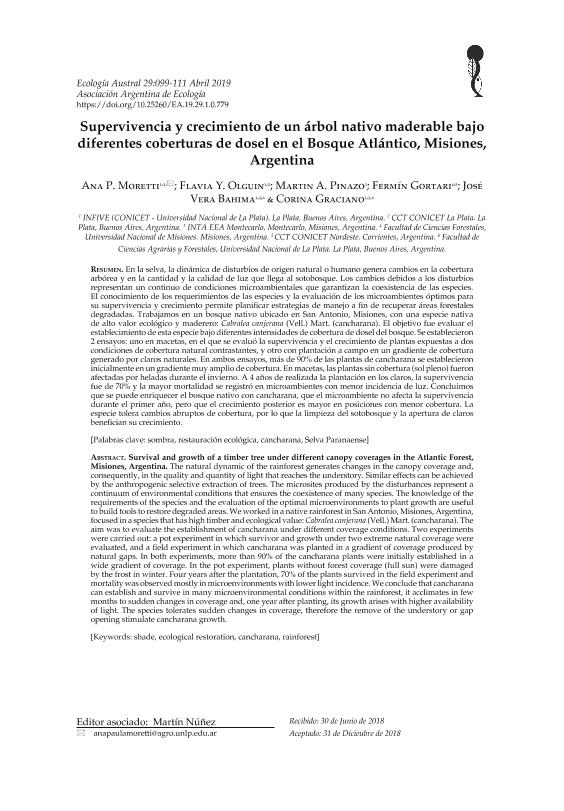Mostrar el registro sencillo del ítem
dc.contributor.author
Moretti, Ana Paula

dc.contributor.author
Olguin, Flavia Yesica

dc.contributor.author
Pinazo, Martín Alcides

dc.contributor.author
Gortari, Fermin

dc.contributor.author
Vera Bahima, José

dc.contributor.author
Graciano, Corina

dc.date.available
2022-02-16T20:15:46Z
dc.date.issued
2019-02-19
dc.identifier.citation
Moretti, Ana Paula; Olguin, Flavia Yesica; Pinazo, Martín Alcides; Gortari, Fermin; Vera Bahima, José; et al.; Supervivencia y crecimiento de un árbol nativo maderable bajo diferentes coberturas de dosel en el Bosque Atlántico, Misiones, Argentina; Asociación Argentina de Ecología; Ecología Austral; 29; 1; 19-2-2019; 99-111
dc.identifier.issn
0327-5477
dc.identifier.uri
http://hdl.handle.net/11336/152159
dc.description.abstract
En la selva, la dinámica de disturbios de origen natural o humano genera cambios en la cobertura arbórea y en la cantidad y la calidad de luz que llega al sotobosque. Los cambios debidos a los disturbios representan un continuo de condiciones microambientales que garantizan la coexistencia de las especies. El conocimiento de los requerimientos de las especies y la evaluación de los microambientes óptimos para su supervivencia y crecimiento permite planificar estrategias de manejo a fin de recuperar áreas forestales degradadas. Trabajamos en un bosque nativo ubicado en San Antonio, Misiones, con una especie nativa de alto valor ecológico y maderero: Cabralea canjerana (Vell.) Mart. (cancharana). El objetivo fue evaluar el establecimiento de esta especie bajo diferentes intensidades de cobertura de dosel del bosque. Se establecieron 2 ensayos: uno en macetas, en el que se evaluó la supervivencia y el crecimiento de plantas expuestas a dos condiciones de cobertura natural contrastantes, y otro con plantación a campo en un gradiente de cobertura generado por claros naturales. En ambos ensayos, más de 90% de las plantas de cancharana se establecieron inicialmente en un gradiente muy amplio de cobertura. En macetas, las plantas sin cobertura (sol pleno) fueron afectadas por heladas durante el invierno. A 4 años de realizada la plantación en los claros, la supervivencia fue de 70% y la mayor mortalidad se registró en microambientes con menor incidencia de luz. Concluimos que se puede enriquecer el bosque nativo con cancharana, que el microambiente no afecta la supervivencia durante el primer año, pero que el crecimiento posterior es mayor en posiciones con menor cobertura. La especie tolera cambios abruptos de cobertura, por lo que la limpieza del sotobosque y la apertura de claros benefician su crecimiento.
dc.description.abstract
The natural dynamic of the rainforest generates changes in the canopy coverage and, consequently, in the quality and quantity of light that reaches the understory. Similar effects can be achieved by the anthropogenic selective extraction of trees. The microsites produced by the disturbances represent a continuum of environmental conditions that ensures the coexistence of many species. The knowledge of the requirements of the species and the evaluation of the optimal microenvironments to plant growth are useful to build tools to restore degraded areas. We worked in a native rainforest in San Antonio, Misiones, Argentina, focused in a species that has high timber and ecological value: Cabralea canjerana (Vell.) Mart. (cancharana). The aim was to evaluate the establishment of cancharana under different coverage conditions. Two experiments were carried out: a pot experiment in which survivor and growth under two extreme natural coverage were evaluated, and a field experiment in which cancharana was planted in a gradient of coverage produced by natural gaps. In both experiments, more than 90% of the cancharana plants were initially established in a wide gradient of coverage. In the pot experiment, plants without forest coverage (full sun) were damaged by the frost in winter. Four years after the plantation, 70% of the plants survived in the field experiment and mortality was observed mostly in microenvironments with lower light incidence. We conclude that cancharana can establish and survive in many microenvironmental conditions within the rainforest, it acclimates in few months to sudden changes in coverage and, one year after planting, its growth arises with higher availability of light. The species tolerates sudden changes in coverage, therefore the remove of the understory or gap opening stimulate cancharana growth.
dc.format
application/pdf
dc.language.iso
spa
dc.publisher
Asociación Argentina de Ecología

dc.rights
info:eu-repo/semantics/openAccess
dc.rights.uri
https://creativecommons.org/licenses/by/2.5/ar/
dc.subject
SOMBRA
dc.subject
RESTAURACIÓN ECOLÓGICA
dc.subject
CANCHARANA
dc.subject
SELVA PARANAENSE
dc.subject.classification
Silvicultura

dc.subject.classification
Agricultura, Silvicultura y Pesca

dc.subject.classification
CIENCIAS AGRÍCOLAS

dc.title
Supervivencia y crecimiento de un árbol nativo maderable bajo diferentes coberturas de dosel en el Bosque Atlántico, Misiones, Argentina
dc.title
Survival and growth of a timber tree under different canopy coverages in the Atlantic Forest, Misiones, Argentina
dc.type
info:eu-repo/semantics/article
dc.type
info:ar-repo/semantics/artículo
dc.type
info:eu-repo/semantics/publishedVersion
dc.date.updated
2020-12-09T20:15:18Z
dc.journal.volume
29
dc.journal.number
1
dc.journal.pagination
99-111
dc.journal.pais
Argentina

dc.journal.ciudad
Ciudad Autónoma de Buenos Aires
dc.description.fil
Fil: Moretti, Ana Paula. Consejo Nacional de Investigaciones Científicas y Técnicas. Centro Científico Tecnológico Conicet - La Plata. Instituto de Fisiología Vegetal. Universidad Nacional de La Plata. Facultad de Ciencias Naturales y Museo. Instituto de Fisiología Vegetal; Argentina
dc.description.fil
Fil: Olguin, Flavia Yesica. Consejo Nacional de Investigaciones Científicas y Técnicas. Centro Científico Tecnológico Conicet - La Plata. Instituto de Fisiología Vegetal. Universidad Nacional de La Plata. Facultad de Ciencias Naturales y Museo. Instituto de Fisiología Vegetal; Argentina
dc.description.fil
Fil: Pinazo, Martín Alcides. Instituto Nacional de Tecnología Agropecuaria; Argentina
dc.description.fil
Fil: Gortari, Fermin. Universidad Nacional de Misiones. Facultad de Ciencias Forestales; Argentina. Consejo Nacional de Investigaciones Científicas y Técnicas. Centro Científico Tecnológico Conicet - Nordeste; Argentina
dc.description.fil
Fil: Vera Bahima, José. Consejo Nacional de Investigaciones Científicas y Técnicas. Centro Científico Tecnológico Conicet - La Plata. Instituto de Fisiología Vegetal. Universidad Nacional de La Plata. Facultad de Ciencias Naturales y Museo. Instituto de Fisiología Vegetal; Argentina. Universidad Nacional de La Plata. Facultad de Ciencias Agrarias y Forestales; Argentina
dc.description.fil
Fil: Graciano, Corina. Consejo Nacional de Investigaciones Científicas y Técnicas. Centro Científico Tecnológico Conicet - La Plata. Instituto de Fisiología Vegetal. Universidad Nacional de La Plata. Facultad de Ciencias Naturales y Museo. Instituto de Fisiología Vegetal; Argentina. Universidad Nacional de La Plata. Facultad de Ciencias Agrarias y Forestales; Argentina
dc.journal.title
Ecología Austral

dc.relation.alternativeid
info:eu-repo/semantics/altIdentifier/url/http://ojs.ecologiaaustral.com.ar/index.php/Ecologia_Austral/article/view/779
dc.relation.alternativeid
info:eu-repo/semantics/altIdentifier/doi/http://dx.doi.org/10.25260/EA.19.29.1.0.779
Archivos asociados
